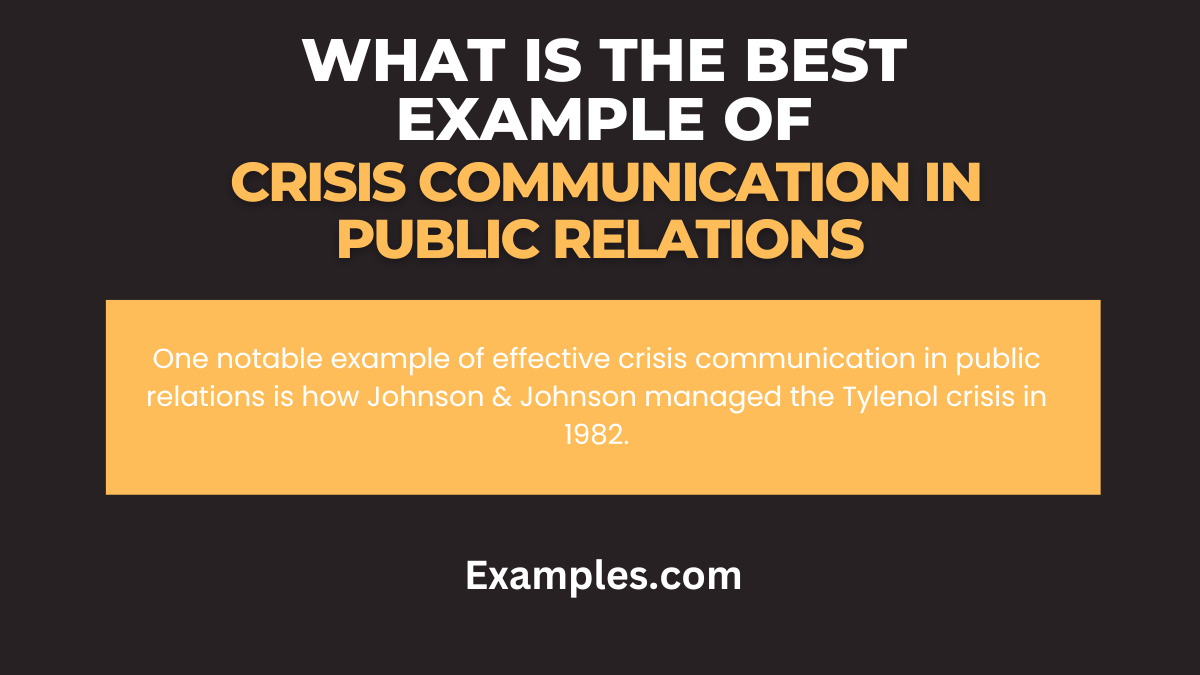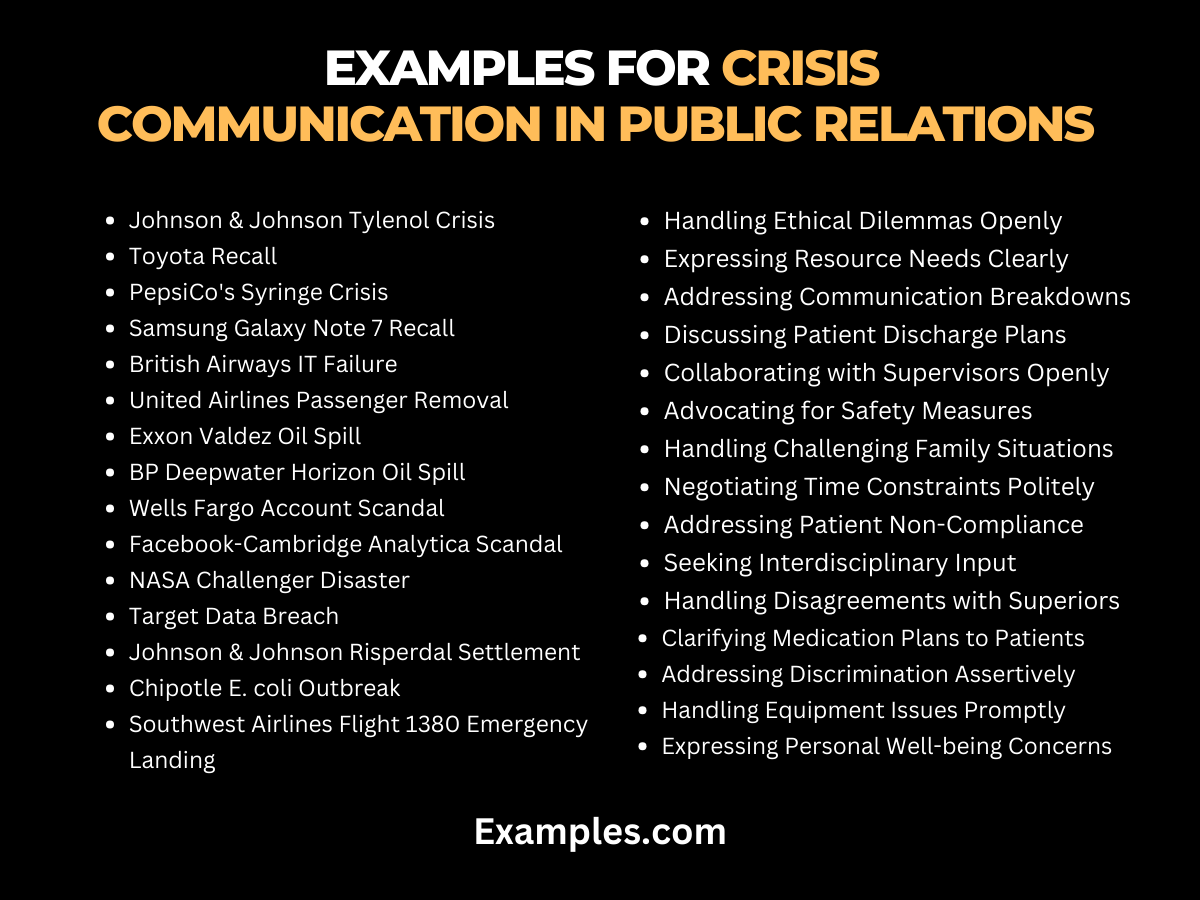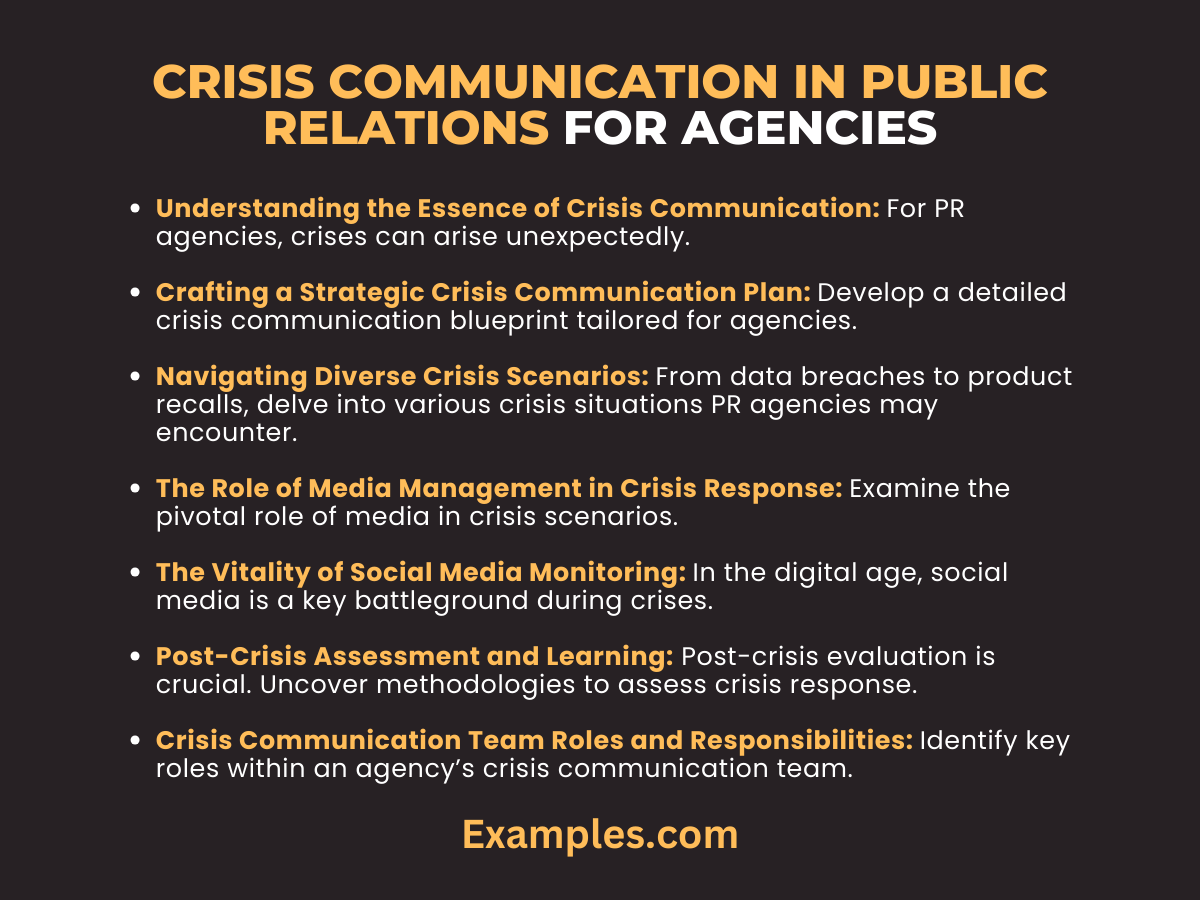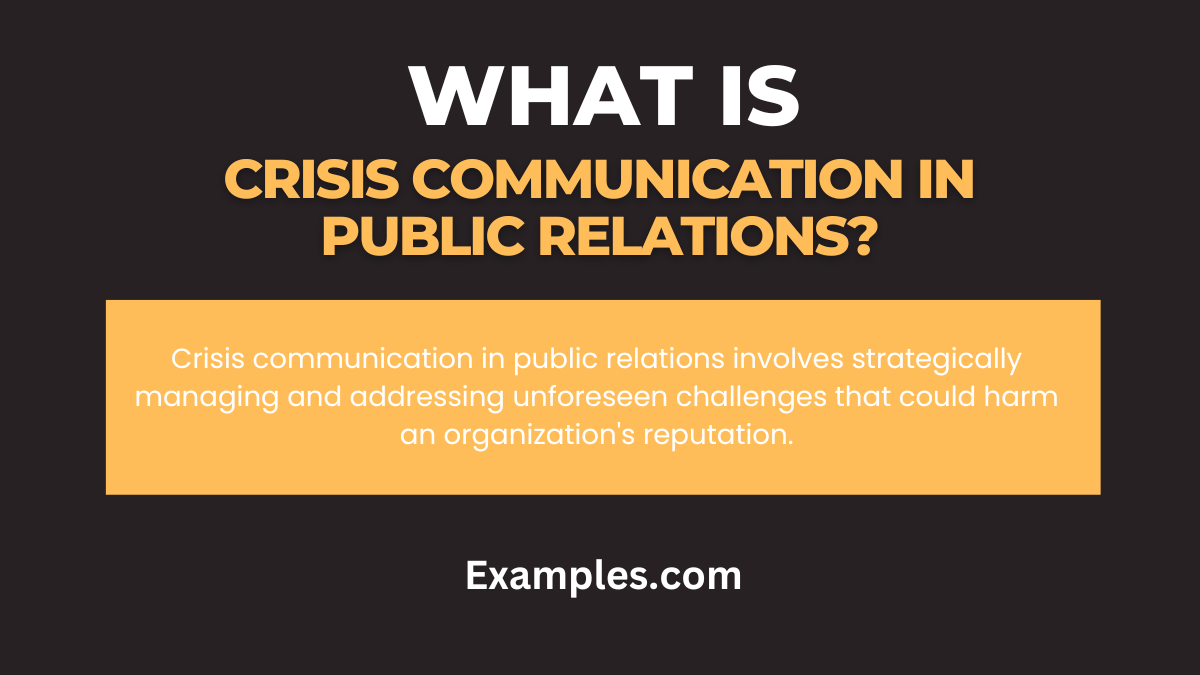29+ Crisis Communication in Public Relations Examples
Crisis Communication in Public Relations is the art of managing and mitigating reputational challenges. Explore the definition, examples, and historical context of this crucial PR discipline. Uncover effective strategies on how to navigate crises and gain valuable tips to bolster your crisis communication toolkit. From its origins to actionable tips, delve into the world of crisis communication to fortify your public relations approach and safeguard your organization’s image with confidence.
What is Crisis Communication in Public Relations?
Crisis communication in public relations involves strategically managing and addressing unforeseen challenges that could harm an organization’s reputation. It focuses on transparent and effective communication to mitigate the impact of crises, encompassing a range of strategies to navigate sensitive situations and maintain public trust.
What is the Best Example of Crisis Communication in Public Relations

One notable example of effective crisis communication in public relations is how Johnson & Johnson managed the Tylenol crisis in 1982. The company responded swiftly, prioritizing public safety over profit. They recalled products, communicated transparently, and implemented tamper-proof packaging, setting a benchmark for crisis management. This decisive action and open communication restored consumer trust despite the initial setback.
30 Crisis Communication in Public Relations Examples

Effective crisis communication is vital for maintaining trust. Explore these 30 diverse examples that showcase strategic approaches in managing crises.
- Johnson & Johnson Tylenol Crisis : Swift recall, transparent communication, and tamper-proof packaging restored trust.
- Toyota Recall : Openly addressing defects and implementing corrective measures reassured consumers.
- PepsiCo’s Syringe Crisis : Communicated proactively to dispel rumors and regain consumer confidence.
- Samsung Galaxy Note 7 Recall : Transparently acknowledging faults and issuing recalls to prioritize safety.
- British Airways IT Failure : Timely communication and compensation efforts mitigated passenger dissatisfaction.
- United Airlines Passenger Removal : Addressing the incident promptly and implementing policy changes for improvement.
- Exxon Valdez Oil Spill : Honest communication, responsibility acceptance, and extensive cleanup efforts.
- BP Deepwater Horizon Oil Spill : Open communication, accepting responsibility, and substantial environmental restoration.
- Wells Fargo Account Scandal : Transparently addressing fraudulent practices and implementing corrective actions.
- Facebook-Cambridge Analytica Scandal : Acknowledging privacy breaches, tightening security measures, and transparency initiatives.
- NASA Challenger Disaster : Transparent communication, investigation, and procedural improvements for space shuttle missions.
- Target Data Breach : Communicating the breach promptly, taking corrective actions, and enhancing cybersecurity.
- Johnson & Johnson Risperdal Settlement: Addressing legal challenges transparently and implementing regulatory compliance measures.
- Chipotle E. coli Outbreak : Rapid response, restaurant closures, and implementing strict food safety protocols.
- Southwest Airlines Flight 1380 Emergency Landing : Compassionate communication, passenger support, and fleet inspections.
- Volkswagen Emissions Scandal : Transparently admitting wrongdoing, recalling affected vehicles, and committing to eco-friendly initiatives.
- Boeing 737 Max Crisis : Admitting faults, grounding planes, and collaborative efforts with aviation authorities for safety improvements.
- Coca-Cola’s Belgium Contamination Scare : Swift recall, transparent communication, and implementing strict quality control measures.
- Netflix Qwikster Fiasco : Responsive communication, acknowledging customer feedback, and revising business strategies.
- GM Ignition Switch Recall : Openly addressing defects, recalling affected vehicles, and compensating affected parties.
- Delta Airlines System Outage: Transparent communication, providing continuous updates, and compensation for affected passengers.
- Nestle Infant Formula Crisis : Acknowledging product safety concerns, recalling affected batches, and implementing quality checks.
- Siemens Bribery Scandal : Transparently addressing legal issues, cooperating with authorities, and implementing rigorous compliance measures.
- Johnson & Johnson Opioid Crisis : Acknowledging responsibility, contributing to opioid crisis solutions, and implementing controlled substance monitoring.
- Takata Airbag Recall : Swift recall, transparent communication, and prioritizing customer safety through replacements.
- Maclaren Stroller Recall : Rapid recall, safety upgrades, and communicating directly with affected consumers.
- KFC Chicken Crisis : Transparent communication during supply chain disruptions and proactive resolution.
- H&M Racist Hoodie Controversy : Immediate apology, product removal, and diversity and inclusion initiatives.
- Uber Data Breach : Transparently communicating the breach, offering support, and implementing enhanced data protection.
- Gap Logo Redesign Backlash : Responsive communication, acknowledging customer feedback, and reverting to the original logo design.
Crisis Communication in Public Relations for Agencies

In the dynamic world of public relations agencies, crisis communication stands as a cornerstone for maintaining brand reputation. Here’s a comprehensive guide focusing on how agencies can navigate crises effectively to uphold client trust and reputation resilience.
Understanding the Essence of Crisis Communication: For PR agencies, crises can arise unexpectedly. Explore the significance of timely and effective crisis communication strategies to safeguard clients’ public image.
Crafting a Strategic Crisis Communication Plan: Develop a detailed crisis communication blueprint tailored for agencies. Emphasize rapid response, transparent messaging, and stakeholder engagement.
Navigating Diverse Crisis Scenarios: From data breaches to product recalls, delve into various crisis situations PR agencies may encounter. Learn how to address each with tailored communication strategies.
The Role of Media Management in Crisis Response: Examine the pivotal role of media in crisis scenarios. Understand how to manage media relations to control narratives and maintain brand integrity.
The Vitality of Social Media Monitoring: In the digital age, social media is a key battleground during crises. Explore effective strategies to monitor, engage, and respond on social platforms.
Post-Crisis Assessment and Learning: Post-crisis evaluation is crucial. Uncover methodologies to assess crisis response, learn from shortcomings, and fortify future crisis communication strategies.
Crisis Communication Team Roles and Responsibilities: Identify key roles within an agency’s crisis communication team. Understand the responsibilities each role entails for a cohesive crisis response.
crisis communication plan in the public relations
Effective crisis communication is a cornerstone of successful Public Relations (PR). A well-structured crisis communication plan is crucial for managing and mitigating potential PR disasters. In this guide, we will explore the key components, strategies, and steps involved in creating an impactful crisis communication plan for public relations.
Understanding Crisis Communication in PR: Before delving into the planning process, it’s essential to grasp the concept of crisis communication in the context of public relations. This section will provide a clear definition and highlight the significance of crisis communication in maintaining a positive PR image.
Importance of a Crisis Communication Plan: Explore why having a crisis communication plan is imperative for PR professionals. Understand how a well-prepared plan can safeguard an organization’s reputation, build trust, and minimize the impact of unforeseen crises.
Key Components of an Effective Crisis Communication Plan: Identify the fundamental elements that make up a robust crisis communication plan. From defining roles and responsibilities to establishing communication channels, this section will break down the essential components.
Developing Crisis Communication Strategies: Learn about the most effective strategies for crisis communication in PR. From rapid response to transparent messaging, each strategy plays a crucial role in navigating through challenging situations.
Building Stakeholder Engagement: Stakeholder engagement is pivotal during a crisis. Understand how to effectively communicate with various stakeholders, including employees, customers, and the media, to maintain transparency and trust.
Leveraging Media Management: Explore the role of media management in crisis communication. Learn how to navigate media inquiries, issue press releases, and manage news coverage to control the narrative during a crisis.
crisis communication in guide to the public relations
Navigating crises in public relations demands a strategic approach to communication. This guide unveils the core principles and strategies essential for effective crisis communication in the realm of public relations.
Understanding Crisis Communication: Explore the essence of crisis communication, its significance in PR, and how it differs from routine communication.
Components of a Successful Crisis Communication Plan: Learn about the crucial elements required to construct a robust crisis communication plan in PR.
Importance of Swift and Transparent Communication: Delve into the pivotal role of immediate and transparent messaging during crises to maintain trust and credibility.
Crafting Consistent Messages: Discover the significance of maintaining coherence in messages across various platforms during crises.
Stakeholder Engagement and Collaboration: Explore the strategies involved in engaging stakeholders and fostering collaborative efforts in crisis scenarios.
Media Management Techniques: Understand the art of managing media relations effectively to control the narrative during crises.
Implementing Social Media Monitoring: Learn the importance of monitoring and managing social media platforms in the midst of crises.
The Role of Empathy and Apology: Grasp the impact of empathy and sincere apologies in mitigating the fallout of a crisis in PR.
Emphasizing Factual Accuracy: Explore the necessity of providing accurate information promptly to counter misinformation.
Preparedness Planning and Evaluation: Understand the significance of preparation and post-crisis evaluation to refine future crisis response strategies in PR.
Importance of Crisis Communication in Public Relations
Effective crisis communication is a cornerstone of successful public relations, crucial for safeguarding an organization’s reputation and maintaining stakeholder trust. This guide delves into the pivotal role crisis communication plays in public relations, exploring its significance and offering insights into why organizations must prioritize strategic communication during challenging times.
1. Preserving Reputation and Credibility: Crisis communication serves as a shield against reputational damage. By addressing crises promptly and transparently, organizations can mitigate negative perceptions and safeguard their credibility in the eyes of stakeholders.
2. Building and Maintaining Trust: Trust is a fragile yet essential element in any business or institutional relationship. Crisis communication fosters trust by demonstrating openness, accountability, and a commitment to resolving issues, even in challenging circumstances.
3. Navigating Public Perception: Public perception can make or break an organization. Crisis communication allows proactive management of narratives, helping shape how the public perceives the situation and the steps being taken to address it.
4. Legal and Regulatory Compliance: Effectively communicating during a crisis is not just a matter of public perception; it also plays a crucial role in adhering to legal and regulatory requirements. Clear communication can aid in compliance and help organizations avoid legal repercussions.
5. Limiting Business Disruptions: A well-executed crisis communication plan minimizes disruptions to daily operations. By providing clear information and guidance, organizations can help employees, clients, and partners navigate uncertainties, ensuring smoother operations during challenging times.
6. Demonstrating Leadership and Responsibility: Crisis communication showcases leadership qualities and a sense of responsibility. Taking ownership of a situation, providing solutions, and communicating effectively demonstrate an organization’s commitment to its stakeholders.
7. Preserving Stakeholder Relationships: Stakeholders, including customers, employees, investors, and the community, are vital to an organization’s success. Crisis communication helps preserve these relationships by keeping stakeholders informed, engaged, and reassured during turbulent times.
8. Competitive Advantage in Crisis Management: Organizations that excel in crisis communication gain a competitive edge. Proactively addressing crises can distinguish a company from competitors, reinforcing its resilience and ability to manage challenges effectively.
9. Preparing for Future Challenges: Crisis communication is not just reactive; it’s also highly preventive. Developing effective crisis communication strategies prepares organizations for future challenges, helping them respond more adeptly to unforeseen circumstances.
10. Enhancing Organizational Adaptability: Organizations that prioritize crisis communication develop a culture of adaptability. This adaptability extends beyond crisis situations, fostering an environment where teams can respond agilely to various challenges.
What are the Most Effective Crisis Communication Strategies in public relations?
During times of crisis, adept communication strategies are crucial in managing situations. These strategies empower organizations to navigate challenges, uphold transparency, and rebuild trust. Understanding and implementing effective crisis communication strategies in public relations ensures a structured response, minimizing reputational damage and fostering resilience.
1. Rapid Response: Timely and swift responses to crises are pivotal. Establish a designated crisis team capable of immediate action and communication.
2. Transparent Communication: Maintain honesty and transparency in all communications. Openly address the crisis, acknowledging its impact and sharing accurate information.
3. Consistent Messaging: Ensure consistency in messaging across all communication channels. Unified messaging minimizes confusion and reinforces credibility.
4. Stakeholder Engagement: Prioritize engagement with stakeholders, including employees, customers, investors, and the community. Address their concerns and offer transparent updates.
5. Media Management: Proactively manage media relations to control the narrative. Work closely with media outlets to share accurate information and counter misinformation.
6. Social Media Monitoring: Monitor social media platforms vigilantly to address concerns, dispel rumors, and maintain a proactive online presence.
7. Empathy and Apology: Demonstrate empathy and offer genuine apologies when necessary. Empathy humanizes the response, fostering understanding and forgiveness.
8. Factual Accuracy: Ensure all information communicated is factually accurate. Misinformation during a crisis can exacerbate the situation.
9. Preparedness Planning: Develop and rehearse crisis response plans in advance. Preparedness reduces response time and ensures a more coordinated approach.
10. Post-Crisis Evaluation: Conduct a thorough post-crisis evaluation to assess strategies’ effectiveness and identify areas for improvement in future crisis management.
In conclusion, crisis communication in public relations demands a strategic, transparent, and swift response. With effective examples illustrating these principles, this comprehensive guide emphasizes the importance of preparation, empathy, and consistent messaging. By integrating these strategies, organizations can navigate crises successfully, protect their reputation, and emerge stronger.




